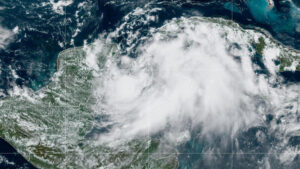AUGUST 28, 2023

A satellite image showing Tropical Storm Idalia on Sunday. – NOAA
Florida is bracing for Tropical Storm Idalia, which formed on Sunday and could strengthen to a hurricane in the next two to three days, forecasters said.
Idalia, the latest named storm of the 2023 Atlantic hurricane season, also threatens to bring heavy rains to Georgia and the Carolinas, forecasters said.
Jamie Rhome, deputy director of the National Hurricane Center, said in an update on Sunday that residents in the Tampa, Fla., area should expect strong winds by Tuesday morning, adding that storm preparations should be completed by Monday night.
“This portion of the Florida peninsula is very storm-surge vulnerable,” he said of the northwest part of Florida. “It will not take a strong system or a direct hit to produce a significant storm surge.”
He said the storm could become a hurricane by the time it reached western Florida on Tuesday, with projected winds of up to 90 miles per hour. Idalia threatens to strengthen in the Gulf, but forecasters are not sure exactly how quickly or by how much it will strengthen.
The Florida Division of Emergency Management told residents to keep their gas tanks halfway full in case emergency evacuation orders were issued.
Gov. Ron DeSantis of Florida signed an executive order on Saturday declaring a state of emergency in 33 counties in preparation for the storm.
“I encourage Floridians to have a plan in place and ensure that their hurricane supply kit is stocked,” he said.
The Hurricane Center, in an advisory on Sunday when the storm was still designated as a tropical depression, noted that from Tuesday into Wednesday, parts of the west coast of Florida, the Florida Panhandle and southern Georgia could get up to six inches of rain, with higher isolated totals of 10 inches.
“There is an increasing risk of life-threatening storm surge, flooding from heavy rainfall and hurricane-force winds along portions of the west coast of Florida and the Florida Panhandle beginning as early as Tuesday,” the center said.
Heavy rainfall was also expected to spread into portions of the Carolinas Wednesday into Thursday, the center said.
It was not immediately clear how severe the effects would be in Georgia and the Carolinas so residents there should watch the forecast closely, Mr. Rhome said.
The west coast of Florida has been no stranger to hurricanes in the past several years.
Hurricane Ian in 2022 and Hurricane Michael in 2018 caused extensive damage from strong winds and storm surges after moving out of the Caribbean and rapidly intensifying in the Gulf of Mexico before striking Florida as major hurricanes.
Michael hit the panhandle, while Ian hit the southwestern edge of the state.
Other storms, like Eta in 2020 and Elsa in 2021, also reached hurricane strength in the Gulf but weakened before making landfall along the Big Bend coast of Florida.
“There’s a notable risk of rapid intensification while the system moves across the record-warm eastern and northeastern Gulf of Mexico,” forecasters with the Hurricane Center said Sunday morning.
The Atlantic hurricane season started on June 1 and runs through Nov. 30.
Franklin became the second hurricane of the Altantic season on Saturday. Tropical Storm Emily was downgraded on Monday to a post-tropical cyclone after forming the day before, and Gert was also short-lived. Tropical Storm Harold formed early Tuesday in the Gulf of Mexico and made landfall in Texas in the morning.
Don, which briefly formed as a hurricane in July, was the first hurricane of the Atlantic season.
In late May, the National Oceanic and Atmospheric Administration predicted that there would be 12 to 17 named storms this year, a “near-normal” amount. On Aug. 10, NOAA officials revised their estimate upward, to 14 to 21 storms.
There were 14 named storms last year, after two extremely busy Atlantic hurricane seasons in which forecasters ran out of names and had to resort to backup lists. (A record 30 named storms took place in 2020.)
There is consensus among scientists that hurricanes are becoming more powerful because of climate change. Although there might not be more named storms overall, the likelihood of major hurricanes is increasing.
Climate change is also affecting the amount of rain that storms can produce. In a warming world, the air can hold more moisture, which means a named storm can hold and produce more rainfall, like Hurricane Harvey did in Texas in 2017, when some areas received more than 40 inches of rain in less than 48 hours.

































































































